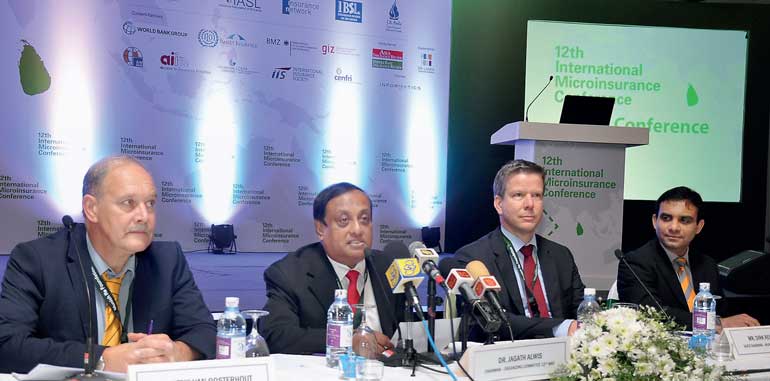Wednesday Dec 24, 2025
Wednesday Dec 24, 2025
Monday, 21 November 2016 00:01 - - {{hitsCtrl.values.hits}}
 From left: Microinsurance Network Interim Executive Director Henk Van Oosterhout, 12th IMIC Organising Committee Chairman Dr. Jagath Alwis, Munich Re Foundation Vice Chairman Dirk Reinhard and Insurance Association of Sri Lanka President Dirk Pereira at the press conference – Pix by Lasantha Kumara
From left: Microinsurance Network Interim Executive Director Henk Van Oosterhout, 12th IMIC Organising Committee Chairman Dr. Jagath Alwis, Munich Re Foundation Vice Chairman Dirk Reinhard and Insurance Association of Sri Lanka President Dirk Pereira at the press conference – Pix by Lasantha Kumara
By Charumini de Silva
Sri Lanka’s insurance services is still only limited to upper and middle income groups, whilst insurance penetration among the lower income segment of the population continues to lag behind industry norms, a report said.
According to ‘Landscape of Microinsurance in Sri Lanka Report 2016’, Microinsurance penetration in the country is a meagre 6.9%. With 24% of the country’s population living on less than $ 2 a day, health is the major risk faced by poor households and given this context the poor are extremely vulnerable due to lack of a safety net in a state of an emergency.
Making a presentation on the ‘Landscape of microinsurance in Sri Lanka’ at the 12th Annual International Microinsurance Conference which kicked off on Tuesday in Colombo Microinsurance Network Interim Executive Director Henk van Oosterhout said although the country has a relatively strong micro finance sector, microinsurance has not been given the same kind of attention.
Hosted for the first time by Insurance Association of Sri Lanka (IASL) in collaboration with the Munich Re Foundation and Micro Insurance Network, the conference aims at providing a suitable platform for insurers, re-insurers, insurance/re-insurance brokers, micro credit agents, insurance regulators, international donor agencies as well as organisations like the World Bank Group and ILO, to meet and exchange views and ideas on the topic of insurance and discuss issues pertaining to the development of microinsurance. The three-day conference is attended with a total of 400 participants from over 50 countries.
According to the report there are no special regulatory provisions in Sri Lanka at present for microinsurance and as a result a number of informal microinsurance schemes operate outside the insurance law. In addition, the regulation of the industry act does not include any provision on the regulation and supervision of mutual insurance companies.
“One of the major challenges the report highlights for the microinsurance coverage in the country was the high administrative costs. As a result, registered insurers are unwilling to market affordable micro-insurance products to the lower income sector as the transaction is not perceived as profitable. Also the low capacity of poverty ridden households to pay premiums also discourages insurance companies which results in a vicious cycle,” van Oosterhout added.
It was pointed out that a few NGOs provide microinsurance services to poor households’ at affordable prices, but operate outside the insurance law.
Emphasising that there is a huge market potential to grow in microinsurance in Sri Lanka, he however said that it needs an enabling environment and support from the mobile network operators (MNOs) in the market to expand the distribution.
Munich Re Foundation Vice Chairman Dirk Reinhard said micro credits and loans are well known, where it helps people prevent fallback into poverty. However, the key problem is that insurance for the low income sector is not available and insurance penetration in this sector is very low.
He stressed that looking at the landscape study done on Sri Lanka they found that in terms of overall protection against any quick disaster it is hardly accessible.
“We want to change this with improved accessibility and improved access to insurance. To change these insurance companies need to get to the regulators, donors, distributions channels like MNOs,” he added.
Noting that ‘mobile insurance’ is a hot topic he said technology is driving the market. “Technology is certainly a driver of growth. The use of mobile phones is rapidly growing and future of financial services is predicted that insurance industry and financial industry will be the most disrupted by technology.”
Despite that technology will get the cost down, he pointed that it will certainly not solve all problems relating to areas such as regulation and education. “End of the day what’s important for the clients is that insurance creates value for them. We need to talk about value creation especially in the sectors of low income market,” Reinhard added.
Highlighting on regulatory microinsurance landscape of Sri Lanka IASL President Dirk Pereira said that the insurance community’s willingness to boost the microinsurance capabilities of the country especially in terms of the regulatory framework.
“At a macro level the regulator has made some substantial changes introducing risk base capital at the start of this year and requiring life and general insurance companies to segregate their businesses. All of these things we believe is positive from a macro insurance perspective” Pereira stressed.
He pointed that whether it is life or general insurance the regulatory framework from a micro finance perspective as well as a microinsurance perspective is reasonably well laid and overlaid by the Government’s commitment to alleviate poverty.
Pereira also acknowledged that there is clearly a protection and a retirement gap in Sri Lanka and insisted insurers and all the other stakeholders to work together to close those gaps.
He elaborated on the promise of microinsurance as the next growth driver for the insurance industry. “I believe that the regulator had identified that if we are to expand the opportunity for insurance in Sri Lanka, microinsurance was a segment that would help propel that growth.”